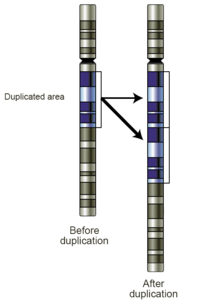
Photo from wikipedia
BACKGROUND Copy number variation sequencing (CNV-seq) could detect most chromosomal abnormalities except polyploidy, and quantitative fluorescence polymerase chain reaction (QF-PCR) is a supplementary method to CNV-seq in triploid detection. This… Click to show full abstract
BACKGROUND Copy number variation sequencing (CNV-seq) could detect most chromosomal abnormalities except polyploidy, and quantitative fluorescence polymerase chain reaction (QF-PCR) is a supplementary method to CNV-seq in triploid detection. This study aimed to evaluate the feasibility of sequential application of CNV-seq and QF-PCR in genetic analysis of miscarriage and stillbirth. METHODS A total of 261 fetal specimens were analyzed by CNV-seq, and QF-PCR was only further performed for samples with normal female karyotype identified by CNV-seq. Cost and turnaround time (TAT) was analyzed for sequential detection strategy. Subgroup analysis and logistic regression were carried out to evaluate the relationship between clinical characteristics (maternal age, gestational age, and number of pregnancy losses) and the occurrence of chromosomal abnormalities. RESULTS Abnormal results were obtained in 120 of 261 (45.98%) cases. Aneuploidy was the most common abnormality (37.55%), followed by triploidy (4.98%) and pathogenic copy number variations (pCNVs) (3.45%). CNV-seq could detect the triploidy with male karyotype, and QF-PCR could further identify the remaining triploidy with female karyotype. In this study, we found more male triploidies than female triploidies. With the same ability in chromosomal abnormalities detection, the cost of sequential strategy decreased by 17.35% compared with combined strategy. In subgroup analysis, significant difference was found in the frequency of total chromosomal abnormalities between early abortion group and late abortion group. Results of logistic regression showed a trend that pregnant women with advanced age, first-time abortion, and abortion earlier than 12 weeks were more likely to detect chromosomal aberrations in their products of conception. CONCLUSION Sequential application of CNV-seq and QF-PCR is an economic and practical strategy to identify chromosomal abnormalities in fetal tissue.
Journal Title: Molecular genetics & genomic medicine
Year Published: 2023
Link to full text (if available)
Share on Social Media: Sign Up to like & get
recommendations!